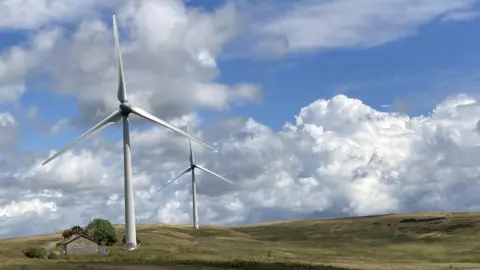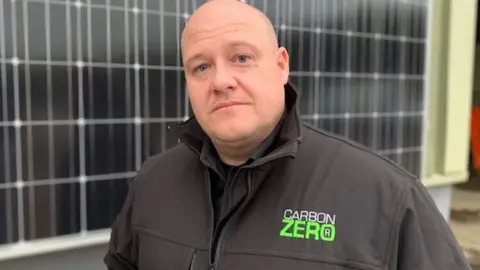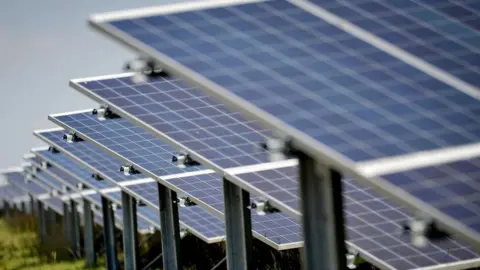Climate change: Action on green power 'needed now'
 BBC
BBCThe boss of Wales' largest renewable energy trade body has warned immediate action is needed to capitalise on green opportunities in the nation's north.
RenewableUK Cymru director, Rhys Wyn Jones, claimed there was "huge" potential to capitalise on water, wind and other power sources.
He said: "If we don't move ahead with things quickly, then we can expect them to move ahead elsewhere."
The UK government said Wales was "pivotal" in reaching net-zero by 2050.
The Welsh government has been asked to comment.
Mr Wyn Jones said decisions were needed now, because changes could take years.
"The renewables industry is very fast-moving," he said.
"It's competitive in an international context (and) here in the UK too."
 Getty Images
Getty ImagesDecisions on things such as infrastructure needed to be made now.
"Are we going to have gas boilers, hydrogen boilers? Are we going to use heat pumps, or are we going to do a mix of both?"
He added that a strong, flexible grid infrastructure was needed, but would probably not be built for "the next decade".
The UK Government said Wales could be a "driving force" in a low-carbon economy and play a "pivotal" role in reaching net-zero emissions by 2050.
It said it was working with the Welsh Government to move to clean power, including a commitment of £20m to start a decarbonisation project in south Wales, £15m to develop electric HGV components in Cwmbran and £5m for the Holyhead hydrogen hub.

What renewable energy sources can Wales use?
For Wales to meet its target of net zero carbon emissions by 2050, it needs a huge increase in renewable energy.
North Wales is already home to Gwynt y Mor, the second biggest offshore wind farm in the world when it opened in 2015.
Tidal, solar and hydrogen power are being explored as possible power sources as well.
A decision on whether to back plans for a large tidal scheme off Anglesey is expected soon from the Welsh government.

The Morlais project, developed by social enterprise Menter Môn, could see one of the largest tidal energy sites on the planet.
About 13 sq miles (35 sq km) of seabed would be developed, generating up to 240MW of electricity from the Irish Sea.
Morlais director, Gerallt Llewelyn Jones, said tidal stream energy was "one of the most important" forms of renewable energy as it was very predictable.
"We know how much we're going to get of it and over what period and, for that reason alone, it's really important that it's included as part of the energy mix this country and the world needs, of low-carbon technologies in order to help us meet the threat of climate change."
 PA
PAIn St Asaph, Denbighshire, Carbon Zero Renewables said it had seen a huge spike in people asking about solar roof panels for their homes.
Managing director Gareth Jones said the company would normally get "one or two" inquiries a week at this time of year, but that had surged to "25 to 30".
Mr Jones believed recent energy price rises were behind increased interest and governments should be "helping people who are looking at long-term future-proofing of their homes".
In March, the UK government announced £4.8m for a green hydrogen production centre in Holyhead, Anglesey.
Ministers claimed the project has the potential to create up to 30 jobs, support 500 more, and bring investment to the area.
Bangor University economics lecturer, Dr Edward Thomas Jones, said hydrogen could be used for multiple purposes, including powering ships or lorries, and Anglesey was well-placed to play a key role.
"If we think about the legacy infrastructure we have here on Anglesey from the old nuclear power plant, we can utilise that."
He also said the island had expertise in the energy field at Menai Science Park and Bangor University and the move to hydrogen could not only help tackle climate change but also boost Anglesey's economy.
